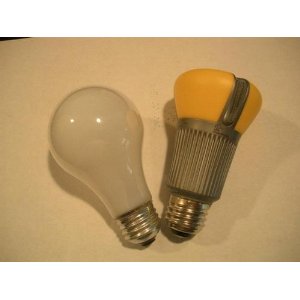 The incandescent light bulb replacement is here. There’s actually two different ones that are intended to replace the 60-watt incandescent light bulb. Philips 12.5-Watt A19 Bulb vs. Philips 10-Watt L-Prize Bulb.
The incandescent light bulb replacement is here. There’s actually two different ones that are intended to replace the 60-watt incandescent light bulb. Philips 12.5-Watt A19 Bulb vs. Philips 10-Watt L-Prize Bulb.
There are other brands and other variations on the market. For the sake of simplicity, we’ll make a comparison with two choices from the same company.
1. Our first choice will be the cheaper of the two and obviously the most popular choice at this time. The Philips 409904 / 423343 Dimmable AmbientLED 12.5-Watt A19 Light Bulb can be purchased for $23.49 at Amazon. The manufacturer claims that it lasts at least 22.8 years and contains no mercury. The no mercury part is good. The longevity is in question. I’m skeptical about this claim.
The Philips 12.5-Watt Ambient LED Energy Saving A19 household light is supposed to replace your 60 watt incandescent, saving you up to $130.62 in energy costs. There are a few minor restrictions with this new bulb, but the buyer needs to be aware of them. It is important to know about this.
For the most part, the initial reaction to the Philips 12.5-Watt bulb has been very positive. The bulb looks modern, is bright, and the lighting is nearly compatible as the incandescent bulb. This is probably the best LED light bulb out there. Again, the drawback is the price. Will the longevity be there?
Some consumers have claimed that the life of the bulb is not what the company says it is. One observer said that after nine months of use the bulbs started blinking. This is troublesome. Some have said that these bulbs produce too much heat.
2. Our second choice is the Philips 423244 10-Watt 60-Watt L-Prize Award Winning LED Light Bulb. The price is $49.97 at Amazon. This bulb is supposed to save you up to $165 in energy costs, while lasting 27.4 years. It contains no mercury.
On August 3, 2011, the winner of the competition to replace the incandescent was Philips, a Dutch multinational electronics company. The winner was a lamp using less than 10 watts. This was to be comparable to the 60 watt incandescent, with 83% energy savings. Philips would get the US $10 million cash prize for the effort.
In conclusion, the majority of consumers are going to go with option number one, which is half of the price of the second choice. You will pay the $23.49 before you will pay $49.97 for a single light bulb. This is a no-brainer.
Call me a skeptic, but I still can’t see either option competing with the incandescent light bulb. Yes, the government is going to ban this bulb in 2014. I just can’t see people paying these prices for lighting. Maybe the prices will go down. Only time will tell. Will you pay this price for a light bulb?

